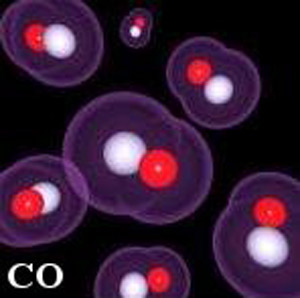carbon monoxide

Carbon monoxide (CO) is a colorless, odorless gas, sparingly soluble in water and soluble in ethanol and benzene. Carbon monoxide is produced by burning carbon or organic compounds in a restricted supply of oxygen, for example in poorly-ventilated stoves, or the incomplete combustion of gasoline in automobile engines. It is manufactured as a component of water gas.
Carbon monoxide reacts with the halogens and sulfur, and with many metals, to give carbonyls. It is an excellent reducing agent at high temperatures, and is used for smelting metal and ores. It is also used for the manufacture of methanol and other organic compounds. It is a component of manufactured gas but not natural gas. It is flammable and burns with a blue flame.
Carbon monoxide is highly toxic. Its toxicity stems from its ability to bind to the iron in hemoglobin, forming the stable, pink compound carboxyhemoglobin, thereby blocking the uptake of oxygen. (This happens if the inhaled air contains as little as 0.1 percent of carbon monoxide by volume.)
| density (at 0°C) | 1.25 g/dm3 |
| melting point | -205°C (-337°F) |
| boiling point | -191.5°C (-312.7°F) |


